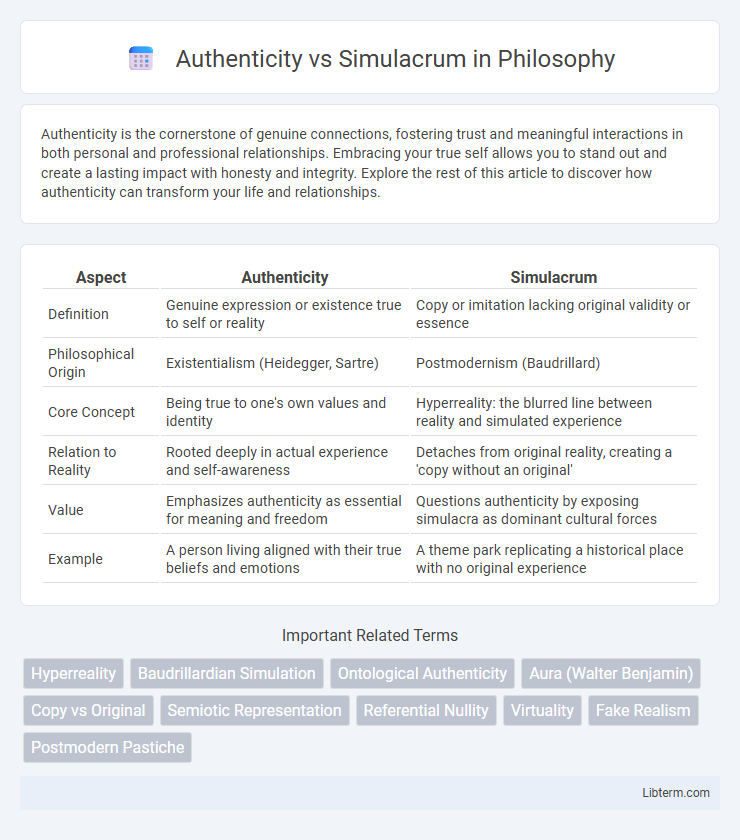Authenticity is the cornerstone of genuine connections, fostering trust and meaningful interactions in both personal and professional relationships. Embracing your true self allows you to stand out and create a lasting impact with honesty and integrity. Explore the rest of this article to discover how authenticity can transform your life and relationships.
Table of Comparison
| Aspect | Authenticity | Simulacrum |
|---|---|---|
| Definition | Genuine expression or existence true to self or reality | Copy or imitation lacking original validity or essence |
| Philosophical Origin | Existentialism (Heidegger, Sartre) | Postmodernism (Baudrillard) |
| Core Concept | Being true to one's own values and identity | Hyperreality: the blurred line between reality and simulated experience |
| Relation to Reality | Rooted deeply in actual experience and self-awareness | Detaches from original reality, creating a 'copy without an original' |
| Value | Emphasizes authenticity as essential for meaning and freedom | Questions authenticity by exposing simulacra as dominant cultural forces |
| Example | A person living aligned with their true beliefs and emotions | A theme park replicating a historical place with no original experience |
Defining Authenticity: Meaning and Significance
Authenticity refers to the genuine, original nature of an object, idea, or experience, emphasizing its true origin and integrity. It signifies a deep connection to reality, often associated with trustworthiness, originality, and cultural or personal identity. In contrast to simulacrum, which denotes a copy or imitation lacking genuine essence, authenticity maintains the intrinsic value and meaning rooted in its authentic source.
Understanding Simulacrum: Origins and Evolution
Simulacrum originates from the Latin word meaning "likeness" or "copy," evolving through philosophical discourse, especially in Jean Baudrillard's theory where reality is replaced by representations. This concept underscores how images or signs no longer reflect reality but create a hyperreality, where distinctions between the authentic and the copy blur. Understanding simulacrum involves recognizing its roots in media, consumer culture, and technology, driving a shift in perception where simulations shape societal values and experiences.
Historical Perspectives: Authenticity in Philosophy and Art
Historical perspectives on authenticity in philosophy and art emphasize the quest for genuine expression rooted in original experience and truth. Philosophers like Heidegger argue authenticity involves being true to one's own existence, while in art, authenticity is linked to artwork's origin, intention, and direct connection to the artist. The rise of simulacra, as discussed by Baudrillard, challenges these notions by presenting copies without originals, blurring the line between authentic and reproduced realities.
Simulacra in the Digital Age: Reality Replaced
Simulacra in the digital age blur the line between reality and representation, where virtual images and experiences often replace authentic encounters. Social media platforms curate idealized versions of life, creating hyperreal environments that distort genuine human interaction. This pervasive simulation challenges traditional notions of authenticity, making it difficult to discern the real from the fabricated.
The Psychology of Perception: What Feels Real?
The psychology of perception highlights how the brain differentiates between authenticity and simulacrum by relying on sensory input, cognitive processing, and contextual cues to determine what feels real. Studies reveal that emotional engagement and prior experiences significantly influence the perception of authenticity, causing simulated experiences to sometimes evoke genuine emotional responses. Neural mechanisms involving the prefrontal cortex and sensory integration play crucial roles in constructing the subjective reality individuals ultimately accept as authentic.
Authenticity vs Simulacrum in Popular Culture
Authenticity vs simulacrum in popular culture reveals the tension between original experiences and their mass-produced imitations, often blurring reality with hyperreality. Media franchises, virtual reality, and social media frequently generate simulacra that challenge perceptions of genuine identity and cultural meaning. This phenomenon questions the value placed on authentic expressions as audiences navigate a landscape saturated with replicated images and narratives.
Branding and Identity: Genuine vs Imitation
Branding thrives on authenticity by establishing a genuine connection between a company's identity and its audience's values, fostering trust and loyalty. Simulacrum brands imitate established ones, often diluting original meanings and confusing consumer perception through superficial replication. Genuine branding leverages transparency, consistency, and unique storytelling to differentiate from imitation, ensuring a lasting emotional resonance.
Social Media: Blurring the Lines of Authenticity
Social media platforms amplify the tension between authenticity and simulacrum by fostering curated self-presentations that blur genuine identity with staged personas. User-generated content often prioritizes idealized images and narratives, creating hyperreal experiences that challenge the distinction between reality and imitation. This digital environment complicates trust and self-perception, as followers engage with representations that may be aesthetically authentic yet inherently performative.
Ethical Considerations: Truth in the Age of Simulation
Ethical considerations surrounding authenticity versus simulacrum emphasize the imperative of truth in an era dominated by digital reproduction and virtual realities. The proliferation of simulacra challenges the distinction between genuine experiences and fabricated imitations, raising concerns about deception, consent, and the manipulation of perception. Maintaining integrity in communication and representation is essential to safeguard social trust and individual autonomy amid the rising influence of hyperreal environments.
Reclaiming Authentic Experience in a Simulated World
Reclaiming authentic experience in a simulated world requires critical awareness of how digital media and virtual environments create layers of representation that often replace genuine interactions. Emphasizing mindfulness and presence helps individuals distinguish between true experiences and mere simulations, fostering deeper emotional and sensory engagement. Cultivating authenticity involves intentional practices that prioritize personal meaning and direct connection over mediated or reproduced realities.
Authenticity Infographic

 libterm.com
libterm.com